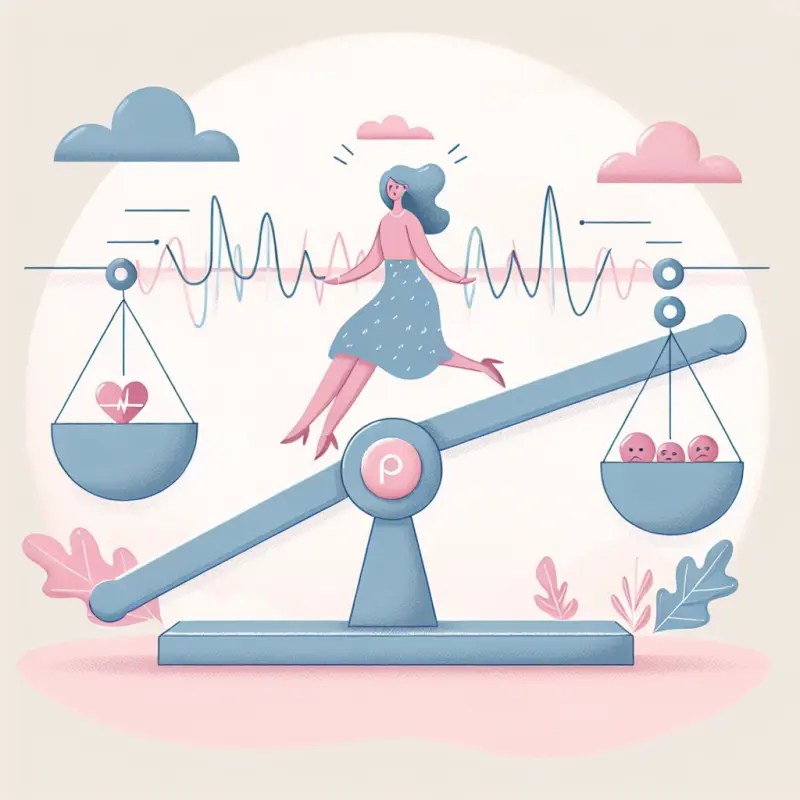Mood Swings in Perimenopause: Distinguishing from Depression

Mood Swings in Perimenopause: Distinguishing from Depression
Introduction
Perimenopause is a transitional phase leading up to menopause, marked by a decline in ovarian function and fluctuating hormone levels. It typically occurs in women between their late 30s and early 50s. This phase can last anywhere from a few months to several years and is characterized by various physical and emotional symptoms, among which mood swings are particularly common.
Mood swings during perimenopause can significantly impact a woman's quality of life, affecting her relationships, work, and overall well-being. Given that mood swings are also a symptom of depression, it can be challenging to distinguish between the two. This article aims to elucidate the differences between mood swings associated with perimenopause and clinical depression, helping women and healthcare providers better understand and manage these conditions.
Understanding Perimenopause
What is Perimenopause?
Perimenopause literally means "around menopause" and signifies the time during which the body transitions toward menopause. This phase involves several physiological changes driven primarily by hormonal fluctuations, particularly in estrogen and progesterone levels.
Symptoms of Perimenopause
The symptoms of perimenopause vary widely among women and can include:
- Irregular Periods: Changes in menstrual cycle length, flow, and frequency.
- Hot Flashes and Night Sweats: Sudden feelings of warmth, often accompanied by perspiration.
- Sleep Problems: Difficulty falling or staying asleep, often due to hot flashes.
- Vaginal Dryness and Discomfort: Changes in vaginal health, possibly affecting sexual activity.
- Mood Swings: Rapid changes in emotional state, including irritability, sadness, or anxiety.
- Memory and Concentration Issues: Difficulty focusing or remembering details.
Mood Swings in Perimenopause
The Biological Basis
Mood swings during perimenopause are often related to hormonal changes, especially fluctuations in estrogen levels. Estrogen has a significant impact on neurotransmitters in the brain, such as serotonin and dopamine, which regulate mood.
Common Manifestations
- Irritability: Feeling agitated or easily annoyed.
- Anxiety: Increased nervousness or worry.
- Sudden Sadness: Unexpected bouts of crying or feeling down.
- Euphoria: Unusually high spirits or excitement.
- Emotional Sensitivity: Heightened reactions to situations that might not typically cause distress.
Factors Influencing Mood Swings
Several factors can influence the severity and frequency of mood swings during perimenopause:
- Lifestyle: Diet, exercise, and sleep quality can affect mood.
- Stress Levels: Chronic stress can exacerbate mood swings.
- Health Conditions: Pre-existing mental health conditions can intensify symptoms.
- Genetic Predispositions: Family history can play a role in how perimenopause affects mood.
Differentiating Perimenopausal Mood Swings from Depression
Clinical Depression: An Overview
Clinical depression, or major depressive disorder, is a mental health condition characterized by persistent feelings of sadness and a lack of interest or pleasure in most activities. It can affect one's ability to function in daily life.
Key Differences
-
Duration and Persistence:
- Mood Swings: Typically short-lived, fluctuating with hormonal changes.
- Depression: Symptoms persist for at least two weeks and are consistent.
-
Intensity of Symptoms:
- Mood Swings: Can be intense but usually return to baseline.
- Depression: Symptoms are pervasive and often severe.
-
Range of Emotions:
- Mood Swings: Include a wide range of emotions, often situational.
- Depression: Predominantly marked by sadness and emptiness.
-
Impact on Functionality:
- Mood Swings: May temporarily affect daily life but do not continuously impair function.
- Depression: Significantly disrupts daily activities, work, and relationships.
-
Physical Symptoms:
- Mood Swings: Often accompanied by other perimenopausal symptoms like hot flashes.
- Depression: May include fatigue, changes in appetite, and sleep disturbances unrelated to perimenopause.
Diagnostic Considerations
Healthcare providers can use specific criteria and tools to differentiate between mood swings and depression:
- Patient History: A comprehensive review of symptoms and their impact on life.
- Psychological Evaluation: Use of standardized questionnaires and interviews.
- Hormonal Tests: In some cases, hormone levels may be assessed to understand the role of perimenopause.
Management Strategies
Managing Perimenopausal Mood Swings
Lifestyle Modifications
- Diet: Incorporate foods high in phytoestrogens, omega-3 fatty acids, and vitamins.
- Exercise: Regular physical activity to boost mood and reduce stress.
- Sleep Hygiene: Establish a consistent sleep routine and create a restful environment.
Stress Management
- Mindfulness and Meditation: Techniques to promote relaxation and emotional balance.
- Therapy and Counseling: Cognitive-behavioral therapy (CBT) can help manage mood fluctuations.
Hormonal Treatments
- Hormone Replacement Therapy (HRT): May alleviate mood swings, though risks and benefits should be thoroughly discussed with a healthcare provider.
Treating Clinical Depression
Medical Treatments
- Antidepressants: Medications such as selective serotonin reuptake inhibitors (SSRIs) are commonly prescribed.
- Psychotherapy: Including CBT and interpersonal therapy (IPT).
Support Systems
- Support Groups: Connecting with others experiencing similar issues can provide emotional support.
- Family and Friends: Engaging loved ones in treatment plans can enhance recovery.
Conclusion
Navigating the emotional landscape of perimenopause can be challenging, but understanding the distinction between mood swings and depression is crucial for effective management. While both conditions can significantly impact quality of life, they require different approaches for treatment and support.
Women experiencing these symptoms should seek guidance from healthcare professionals to obtain an accurate diagnosis and develop a comprehensive management plan. By addressing lifestyle factors, exploring therapeutic options, and leveraging support networks, women can better manage their symptoms and maintain a fulfilling life during this transitional phase.
Ultimately, increased awareness and understanding of perimenopausal mood swings and depression can empower women to take charge of their mental and emotional health, fostering resilience and well-being through the journey to menopause.